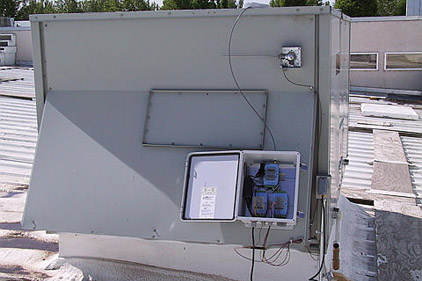The report, titled “Energy Savings and Economics of Advanced Control Strategies for Packaged Air-Conditioning Units with Gas Heat,” was published by the Pacific Northwest National Laboratory (PNNL), a U.S. Department of Energy (DOE) national laboratory. PNNL’s study examined options for improving the efficiency of packaged commercial rooftop systems and estimated the potential savings based on computer modeling and simulation of building energy usage.
“The potential savings from adding advanced controls to existing packaged air conditioners with gas furnaces is enormous,” said PNNL engineer Srinivas Katipamula, who led the study. “The estimated savings depend on local climate and energy prices and range from a whopping 67 percent cost savings in San Francisco to a still substantial 28 percent in Seattle.”
The controls that could provide these savings are not widely available commercially, but Katipamula and the rest of the report’s authors hope their analysis will encourage manufacturers to expand their production.
Climates and Controls
For the report, Katipamula and his colleagues considered implementing four different control methods to existing rooftop packaged HVACs: air-side economizers, supply fan speed controls, cooling capacity controls, and demand-controlled ventilation. The study team tracked the effects of using these methods with EnergyPlus simulation software. The software created computer simulations that took into account 15 climate zones in 16 major U.S. cities.
Four types of buildings were studied: small offices of 5,500 square feet, stand-alone retail buildings of 25,000 square feet, strip malls of 22,500 feet, and supermarkets of 45,000 square feet. More than 1,400 different simulations estimated the potential savings in electricity used to power fans and cooling compressors, as well as the gas used to produce heat. Energy savings were then translated into dollars and cents.
In general, the researchers found that installing a multispeed fan control had the greatest impact on energy savings in hot cities such as Miami. Demand-controlled ventilation created the best possible energy savings in colder cities such as Chicago, Duluth, and Seattle.
When the research team added up all the numbers, they found the best possible percentage cost savings was 67 percent, which could occur when all four controls are added to a rooftop packaged HVAC at a small office building in San Francisco. The minimum percentage cost savings was 28 percent and could come from adding all four controls to a supermarket in Seattle.
Their research also showed that Fairbanks, Alaska, could be home to the maximum annual dollar savings for all four building types. Fairbanks could experience savings as high as $52,217 per year at a supermarket and as low as $923 at a small office. According to the report’s authors, Fairbanks’ dollar-saving advantage is due to its cold climate, which benefits more from the decreased ventilation that occurs with demand-controlled ventilation, as well as the city’s relatively high energy costs.
Return on Investment
Three companies currently manufacture HVAC controllers, but only one company offers a product with all the control options that resemble the team’s simulations, Katipamula said. The report also examined potential prices for the controllers and how long it would take for building owners to recoup that cost.
Based on the estimated dollar savings, the team predicted a building owner could recoup his or her investment in a few years.
“Our report makes a convincing case for manufacturers to produce more advanced HVAC controllers and for building owners to adopt these energy-saving methods,” Katipamula said.
Next, the team will test the estimated savings in the field. They are installing controllers into HVAC systems used on two rooftop units at an office building on PNNL’s campus in Richland, Wash. They are also planning to install several controllers in various commercial buildings across the United States. Once installed, the controllers will allow the researchers to measure real energy and costs savings. The PNNL team also plans to expand its simulations to include more variables, such as heat pumps.
To access the PNNL report “Energy Savings and Economics of Advanced Control Strategies for Packaged Air-Conditioning Units with Gas Heat,” go to http://bit.ly/M0ehHC.
Publication date: 05/28/2012


Report Abusive Comment